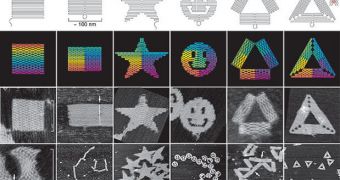A chemistry team based in Denmark announces that it managed to devise a way of attaching single molecules to a DNA origami scaffolding, by observing the chemical reactions via atomic force microscopy (AFM). Their breakthrough could have applications in a large number of scientific fields of research, ranging from biosensing to drug deliver, and even in electronics. Using AFM, the scientists say, could make it easier for other experts to create DNA nanodevices that self-assemble, which is something the scientific community has been aiming at for a long time. They add that the nucleic acid has little practical use of its own, but that it can provide a strong support for other materials.
Because of the selective manner in which its base pairs link to each other, DNA scaffolds could be used to make various types of materials – as for example nanoparticles – stick to each other in a tightly-controlled manner. This could result in devices that could have functionalities that have never been seen before. In chemistry, optics and electronics, DNA can basically be used as a template for producing a wide range of complex structures. Researchers say that the complexity of the finished structure is dependent on the way in which long DNA molecules are folded, when the origami is produced.
But a large part of the capabilities that DNA has is intimately connected to the type of molecules that can be attached to the origami afterwards. Researchers can already image large nanoparticles and molecules as they bind to specified locations on the nuclei acid strand, but they cannot see the smaller groups of sub-molecules, and therefore, they cannot control their location. But a group of experts from the Aarhus University, led by scientist Kurt Gothelf, believes it may have discovered a way to move past this limitation.
“It is the first demonstration of chemical modification of a folded DNA nanostructure, and it holds promise for using DNA origami as a nanofactory for constructing advanced organic molecules,” the team leader says. The team used the protein streptavidin to mark the locations of the various chemicals attached to the DNA origami scaffold. Using AFM, the particular locations in which sub-molecules affixed themselves to the strand became obvious. The group says that more innovation in this technology would eventually allow experts to use it on a large scale, and produce a host of new structures, Chemistry World reports.

 14 DAY TRIAL //
14 DAY TRIAL //